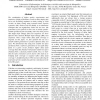Free Online Productivity Tools
i2Speak
i2Symbol
i2OCR
iTex2Img
iWeb2Print
iWeb2Shot
i2Type
iPdf2Split
iPdf2Merge
i2Bopomofo
i2Arabic
i2Style
i2Image
i2PDF
iLatex2Rtf
Sci2ools
IOLTS
2000
IEEE
2000
IEEE
Comparison between Random and Pseudo-Random Generation for BIST of Delay, Stuck-at and Bridging Faults
The combination of higher quality requirements and sensitivity of high performance circuits to delay defects has led to an increasing emphasis on delay testing of VLSI circuits. As delay testing using external testers requires expensive ATE, built-in self test (BIST) is an alternative technique that can significantly reduce the test cost. The generation of test patterns in this case is usually pseudorandom (produced from an LFSR), and it has been proven that Single Input Change (SIC) test sequences are more effective than classical Multiple Input Change (MIC) test sequences when a high robust delay fault coverage is targeted. In this paper, we first question the use of a pseudo-random generation to produce effective delay test pairs. We demonstrate that using truly random test pairs (produced from a software generation) to test path delay faults in a given circuit produces higher delay fault coverage than that obtained with pseudo-random test pairs obtained from a classical primitive ...
| Added | 31 Jul 2010 |
| Updated | 31 Jul 2010 |
| Type | Conference |
| Year | 2000 |
| Where | IOLTS |
| Authors | Patrick Girard, Christian Landrault, Serge Pravossoudovitch, Arnaud Virazel |
Comments (0)

